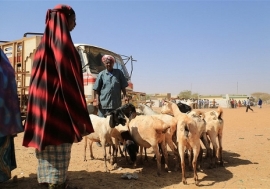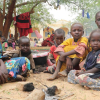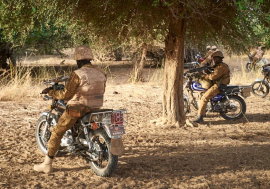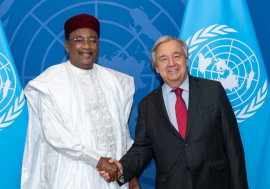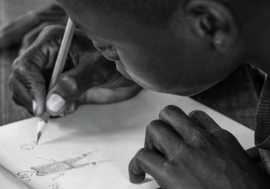In Sahel, battle against child malnutrition continues
In Sahel, battle against child malnutrition continues
Malnutrition among children under age five in the Sahel is expected to rise again this year, despite decent rains and more or less average harvest predictions. Yet as specialists collect robust evidence on the most effective ways to save the lives of 1.5 million children in the region - going beyond food to tackle malaria, boost healthcare, increase vaccination coverage and improve access to clean water as part of integrated packages - donors remain cautious about commitments.
Among the 6.9 million children who died under age five in 2011, just under half lived in sub-Saharan Africa, according to the UN Children’s Fund’s (UNICEF) 2013 State of the World’s Children report. One third of these deaths took place in Burkina Faso, Chad, Mali Niger and Nigeria, says medical charity Médecins Sans Frontières (MSF), with malnutrition being the underlying cause in half of these cases.
“It’s huge,” said Stéphane Doyon, coordinator for the West Africa emergency unit of MSF. “We can’t separate mortality from malnutrition here.”
For the past two years the number of severely acutely malnourished children in the Sahel has risen, reaching 1.5 million in 2013. Combined with the number of under-fives and pregnant women who are moderately acutely malnourished (or experiencing "wasting"), the number of malnourished in the region reaches 5 million.
There are multiple reasons malnutrition cases have risen this year, including high food prices, conflict, high incidence rates of malaria and improved humanitarian coverage - which may mean better reporting of child malnutrition. Other structural causes include weak health systems, deep poverty, poor water and sanitation conditions, and inadequate infant care practices, according to the health and nutrition NGO Alima.
In many Sahelian countries, treatment of children with severe acute malnutrition has reached a pretty much “optimal” level, said Alima’s West Africa director Augustin Augier. In many places, NGOs, UNICEF, the World Food Programme (WFP) and governments have been working around the clock to save lives (albeit with major exceptions, such as northern Nigeria, where reaching children is a huge challenge).
But efforts to prevent the major causes of malnutrition are often not well integrated instead they are “siloed” in pilot projects or “vertical programmes” focusing on vaccinations, healthcare or nutrition, each run by a different organization.
Treat malaria to treat malnutrition
Malaria is the biggest killer of under-fives in the Sahel, according to MSF research, followed by acute respiratory infection, diarrhoea and acute malnutrition. Of course the four are interlinked - malnutrition can make children more vulnerable to death from malaria, for instance, and vice versa. “You have to take all of them in their totality,” said Doyon of MSF.
Each year, malaria cases - or cases that are a combination of malaria and other illnesses - saturate district hospitals during the rainy season, overwhelming district doctors. And the number of children in the Sahel MSF treats for severe and acute malnutrition grows each year, said Doyon. “Given this, we felt we had no choice but to address prevention. We can’t just continue to wait for this wave of illness each year,” he said.
At Konseguela health post, in Koutiala District in Mali’s Sikasso Region, MSF set out to prevent malnutrition by addressing the gamut of related causes. As part of a two-year programme, the organization gave all children antimalarial tablets - whether or not they had the disease - during the four-month malaria season. They also handed out mosquito nets, made rapid malaria tests available and taught community workers how to measure weight loss using arm-circumference measures. As a result, malaria cases went down by 67 percent, malaria deaths dropped by 72 percent, and hospitalizations for all illnesses, including malnutrition, dropped by 63 percent.
The programme also vaccinated children against pneumococcal diseases, administered oral rehydration salts to children with diarrhoea, dispensed chlorine for water treatment, and offered nutritional supplements and regular free follow-up visits from a health worker.
Since the programme started two years ago, stunting in Konseguela has fallen by one-third and child mortality by half. These results were “astonishing” said Doyon.
Similar integrated approaches were implemented in parts of Tahoua, Maradi and Zinder provinces in Niger and in the town of Massakory in Chad.
Just as astonishing, Doyon said, is that 97 percent of mothers stayed in the programme. Often, mothers drop out of health programmes because they cannot return to the clinic for all the health checks, nutrition support and vaccinations required, but this programme, which offered all these services at once, was more doable.
An integrated malnutrition prevention programme by the International Lipid-Based Nutrient Supplements (iLiNS) Project also showed positive results.
Robert Piper, humanitarian coordinator for the Sahel, says the region needs new approaches like these - and not only in the nutrition sector. “This is the time to be having these discussions. The problem is getting away from us, and we need new ideas and solutions.”
Scale up
What’s needed now is to scale up. Donors need to start funding this kind of approach, said Alima’s Augier.
MSF has roughly calculated the expenses: It would cost roughly US$201.25 per child over two years (assuming parts of this sum will be covered by existing funders such as UNICEF and the Gates Foundation). But many aspects of that could be lowered over time, estimates Doyon, including the cost of supplementary food - foods rich in the micronutrients needed by children - which is $113 out of the total. Scale-up would eventually bring prices down, he added.
Treatment for severe acute malnutrition, meanwhile, is $80 to 100, agencies estimate.
National governments cannot take on these programmes alone yet. In Niger, some 20 percent of the 377,000 children who are acutely malnourished this year will require, on average, eight days of hospital treatment. This requires filling up 1,500 hospital beds with patients suffering from acute malnutrition, estimated Augier. But in Zinder and in Niamey, there are only 80 beds each. “People talk about passing on malnutrition treatment to governments, but they simply don’t have the means to take it on,” he stressed. “The same kind of MSF project can’t be done on the same scale Niger-wide.”
National governments must be in the driving seat, said Piper, acknowledging that the kind of capacity required “is phenomenally difficult.”
“You need to do this [scale up] with available mechanisms within governments already…using a database of the vulnerable,” said Cyprien Fabre, the West Africa head of the European Commission Humanitarian Aid Department (ECHO). Governments like Zimbabwe and Ethiopia are doing this, but the Sahel is not there yet.
Donors too, must come on board. Some are concerned that this will happen slowly. “When it comes to donors, we need a strong commitment towards this goal,” said Augier.
ECHO, one of the biggest nutrition funders in the Sahel, is in “full agreement” with integration. “It’s what we’ve been saying for quite a while,” said Fabre. ECHO is already supporting some integration work and is monitoring the field to see which combinations of interventions work - be they cash, vaccinations, agricultural inputs or other assistance.
But Doyon said the proof of what works in prevention is already clear. “We already do this [integrated prevention] everywhere - in Latin America, in Europe, in the US. It’s not new,” he stressed. “We’ve done our work. We’ve documented the results. We’ve financed it ourselves. Now we don’t have the capacity to do it any differently.”
Commitments still vague
Humanitarian donors are supportive in theory, though they are not yet changing their funding strategies.
Integrating packages would involve coordinating donors for example, some donors could focus on malaria, others on vaccines, but as part of an agreed combined package delivered to each child. However, “[donor] coordination is not easy… Each has its own rules and regulations. It’s difficult to get them into line”, said Fabre.
The UK Department for International Development (DFID) is considering funding integrated malnutrition-prevention programmes as part of its 2014-2017 strategy, but it has yet to finalize its plans, said Nadia Jeanne Guillin, DFID’s Sahel humanitarian adviser.
The US Agency for International Development did not spell out whether it would take an integrated approach to nutrition as staff are unable to speak due to the US government shutdown. They are, however, tackling resilience by combining nutrition, food security, agriculture and health interventions.
The UN’s shift to a three-year funding appeal for the Sahel, meanwhile, shows “we’re recognizing a new approach is needed to deal with these chronic issues. It shows lessons are being learned”, said Piper.
For such approaches to gain momentum, development donors must come on board, both with money and with targeting.
“Essentially, all agencies involved would need to agree on a shared set of clients,” said Piper.
Humanitarian agencies’ clients usually overlap, but “these same households need to be at the heart of development planners’ strategies - that’s the sea change that’s needed,” he said.



